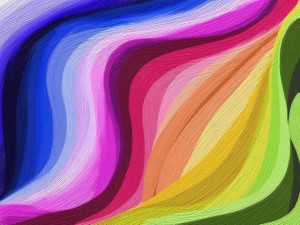
 If you experience road rage, you may be said to be “seeing red.” If you’re sad, people may describe you as “feeling blue.” Smiling at everyone you meet? Others may say you’re “sunny,” or yellow.
If you experience road rage, you may be said to be “seeing red.” If you’re sad, people may describe you as “feeling blue.” Smiling at everyone you meet? Others may say you’re “sunny,” or yellow.
Why do we describe so many of our emotions with colors? According to some studies, colors have a way of affecting our psychological functioning, and may also have the ability to help affect how well-or unwell-we may feel.
Studies Show the Affects of Color
Though some scientists are still skeptical about the affects that color may or may not have on our well being, some studies have shown that colors can make changes in how we perform or feel. Research published in the 2007, for example, found that college students who were presented with the color red before an exam had scores 20 percent lower than those students presented with green or black.
A second study showed that people react faster and more forcefully when they see the color red, yet study participants were unaware of the color’s intensifying effect. “Red enhances our physical reactions because it is seen as a danger cue,” co-author Andrew Elliott explained. Other studies have shown that athletes competing against an opponent wearing red are more likely to lose, as the color can evoke worry and task distraction.
Color Can Encourage Learning
Writing for the International Center for Leadership in Education, Dr. William R. Daggett and colleagues noted that color is an important factor in the physical learning environment, and impacts student achievement, as well as teacher effectiveness. The doctors recommend certain colors for certain areas of school:
- to encourage activity the gym-red, red-orange, light orange
- to promote healthy eating in the cafeteria-green, lime, orange
- to promote stillness in the study hall-blue, brown, earth tones
- to encourage dignity and manners and in the auditorium-violet, navy, purple, burgundy
Using Colors in Healing
Can colors actually help heal the body? According to some modes of thought, yes. Called “chromotherapy,” “light therapy” and “colorology,” the technique of using color to heal was believed to be originally developed by ancient people in India, Greece, China, and Egypt. They believed that red stimulated body and mind and increased circulation, yellow stimulated the nerves and purified the body, orange increased energy levels, blue soothed illnesses and pain, and indigo helped alleviate skin problems.
In 1876, physician Augustus Pleasanton published Blue and Sun-Lights, reporting his findings on the effects of color on plants, animals and humans. In 1877, physician Edwin Babbitt advanced a comprehensive theory of healing with color.
Since then, color has been shown to alter brain wave activity and the production of hormones that affect mood, energy level, and mental clarity. Research on prison behavior, for example, showed increased violence in red and yellow painted wings, rather than blue and green wings. Pink reduced prisoner hostility and aggressiveness by reducing energy levels. The relationship between color and emotion can also be affected by preferences, however, so one person’s reaction to blue may be different from another’s.
Color Therapy
Today, color therapy is likely to be used by those who practice other alternative healing methods, such as acupuncture, Reiki, ayurveda, and others. Color therapy encompasses a number of methods used to encourage healing. Some of the ways colors are used in these therapies include the following:
- Meditation: you may focus your mind on a color you find relaxing
- Breathing: like meditation, you visualize specific colors according to the benefit you’re looking for
- Color Puncture: focused colored lights are directed at acupuncture points on the body to active healing pulses of energy
- Surroundings: changing the color of your office, clothing, or home can help improve emotional and physical disturbances
- Ocular Light Therapy: light is projected through colored filters into the eyes, sometimes used to treat psychological disorders
You may find that changing the colors in your surroundings may have an effect on your mood and well being. If you want to try it, start with these guidelines of what certain colors may symbolize, provided by MindBodyGreen:
- Black: authority, power, strength, intelligence, slimming
- White: purity, cleanliness, spaciousness
- Gray: neutral, practical
- Red: romance, energy, excitement, intensity
- Orange: energetic, enthusiasm, warmth
- Yellow: happiness, cheery, optimism
- Green: cool, health, tranquility, natural
- Blue: calmness, serenity, wisdom, truth
- Purple: sophistication, exotic, spiritual, mystery, creative
- Brown: reliable, stable, security, organic
- Pink: gentle, calming
Do you feel you’re affected by colors? Please share your thoughts.
Photo courtesy khchee via Flickr.com.
Sources
Andrew J. Elliot, et al., “Color and Psychological Functioning: The Effect of Red on Performance Attainment,” Journal of Experimental Psychology, February 2007, Vol 136(1): 154-168, http://psycnet.apa.org/journals/xge/136/1/154/.
“Color Red Increases the Speed and Strength of Reactions,” University of Rochester, June 2, 2011, http://www.rochester.edu/news/show.php?id=3856.
Dr. Willard R. Daggett, et al., “Color in an Optimum Learning Environment,” International Center for Leadership in Education, http://www.leadered.com/pdf/Color%20white%20paper.pdf.
“Color Therapy,” InteliHealth, The Trusted Source, http://www.intelihealth.com/IH/ihtIH/WSIHW000/8513/34968/358753.html?d=dmtContent.

